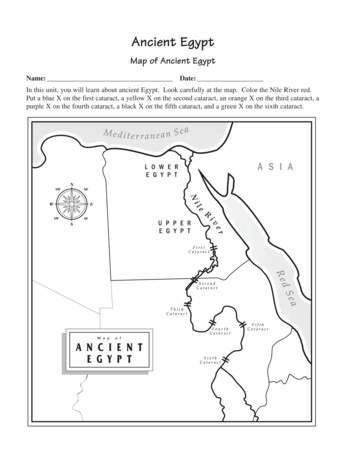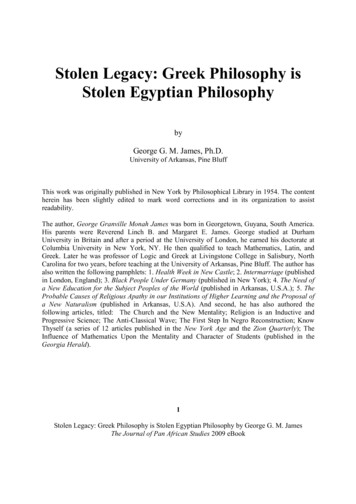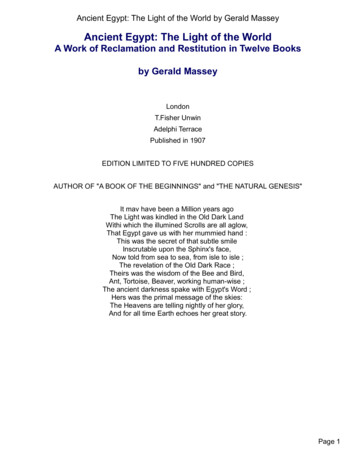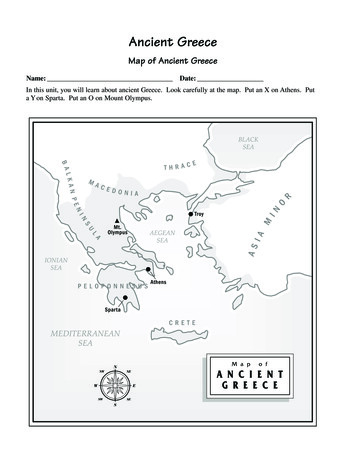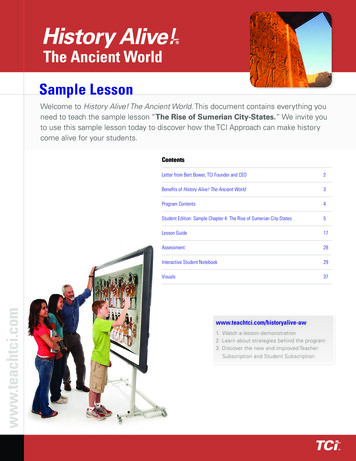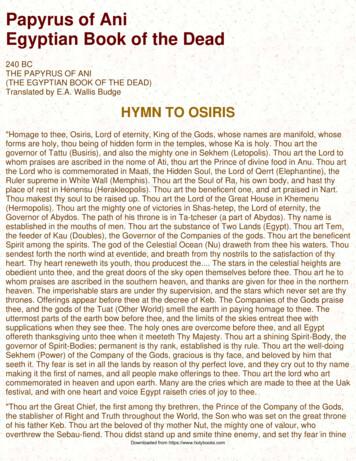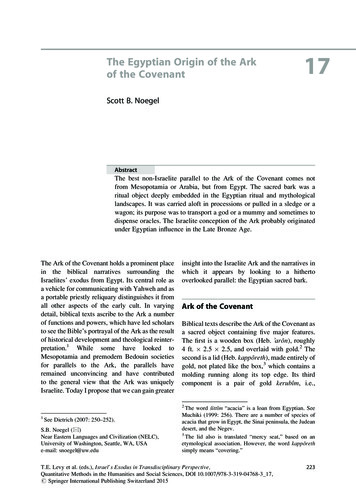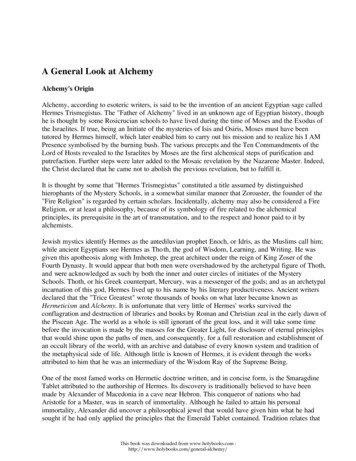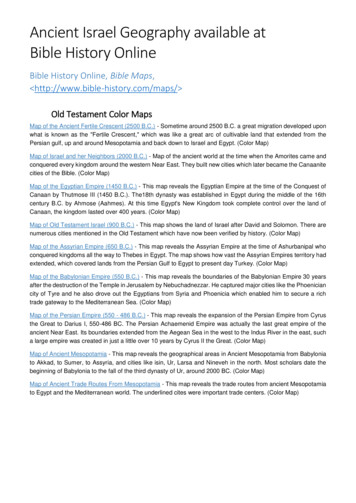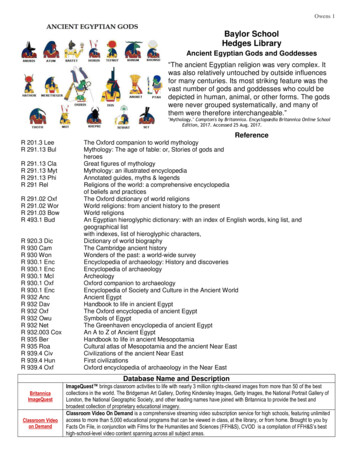
Transcription
Owens 1Baylor SchoolHedges LibraryAncient Egyptian Gods and Goddesses“The ancient Egyptian religion was very complex. Itwas also relatively untouched by outside influencesfor many centuries. Its most striking feature was thevast number of gods and goddesses who could bedepicted in human, animal, or other forms. The godswere never grouped systematically, and many ofthem were therefore interchangeable.”"Mythology." Compton's by Britannica. Encyclopædia Britannica Online SchoolEdition, 2017. Accessed 25 Aug. 2017.ReferenceR 201.3 LeeR 291.13 BulR 291.13 ClaR 291.13 MytR 291.13 PhiR 291 RelR 291.02 OxfR 291.02 WorR 291.03 BowR 493.1 BudR 920.3 DicR 930 CamR 930 WonR 930.1 EncR 930.1 EncR 930.1 McIR 930.1 OxfR 930.1 EncR 932 AncR 932 DavR 932 OxfR 932 OwuR 932 NetR 932.003 CoxR 935 BerR 935 RoaR 939.4 CivR 939.4 HunR 939.4 OxfThe Oxford companion to world mythologyMythology: The age of fable: or, Stories of gods andheroesGreat figures of mythologyMythology: an illustrated encyclopediaAnnotated guides, myths & legendsReligions of the world: a comprehensive encyclopediaof beliefs and practicesThe Oxford dictionary of world religionsWorld religions: from ancient history to the presentWorld religionsAn Egyptian hieroglyphic dictionary: with an index of English words, king list, andgeographical listwith indexes, list of hieroglyphic characters,Dictionary of world biographyThe Cambridge ancient historyWonders of the past: a world-wide surveyEncyclopedia of archaeology: History and discoveriesEncyclopedia of archaeologyArcheologyOxford companion to archaeologyEncyclopedia of Society and Culture in the Ancient WorldAncient EgyptHandbook to life in ancient EgyptThe Oxford encyclopedia of ancient EgyptSymbols of EgyptThe Greenhaven encyclopedia of ancient EgyptAn A to Z of Ancient EgyptHandbook to life in ancient MesopotamiaCultural atlas of Mesopotamia and the ancient Near EastCivilizations of the ancient Near EastFirst civilizationsOxford encyclopedia of archaeology in the Near EastDatabase Name and DescriptionBritannicaImageQuestClassroom Videoon DemandImageQuest brings classroom activities to life with nearly 3 million rights-cleared images from more than 50 of the bestcollections in the world. The Bridgeman Art Gallery, Dorling Kindersley Images, Getty Images, the National Portrait Gallery ofLondon, the National Geographic Society, and other leading names have joined with Britannica to provide the best andbroadest collection of proprietary educational imagery.Classroom Video On Demand is a comprehensive streaming video subscription service for high schools, featuring unlimitedaccess to more than 5,000 educational programs that can be viewed in class, at the library, or from home. Brought to you byFacts On File, in conjunction with Films for the Humanities and Sciences (FFH&S), CVOD is a compilation of FFH&S’s besthigh-school-level video content spanning across all subject areas.
Daily Life pædiaBritannica SchoolEditionNew Book ofPopular ScienceProQuest CentralK12ProQuest HistoryStudy CenterSalem PressHistory DatabasesWorld BookEncyclopediaWorld History:Ancient &Medieval ErasABC-CLIOOwens 2In Daily Life through History, students and researchers discover the everyday details about past eras that make historicalaccounts relevant and meaningful.A standard in school, academic, and public libraries, the Encyclopedia Americana is easy to search online. This databasehelps middle- to upper-grade students find a wealth of information to assist with homework and research projects.You can searchEncyclopædia Britannica Online School Edition provides access to databases:encyclopedias as Encyclopædia Britannica for high school students and up,well as magazines, Comptons by Britannica for middle school students and up andWeb sites, videos, Britannica Elementary for elementary students and up.and other tools.New Book of Popular Science WEB based on the six-volume print edition, the online version offers a variety of science andtechnology material including NewsBytes; SciClopedia; Celestial Maps in the SkyWatch section; Teachers' Guides; SciZone,with mind benders and word search; and SciFile, with conversion factors, mathematical formulas, etc.ProQuest Central K12 offers a comprehensive publication collection that meets a wide range of research demands. Fromgeneral reference to advanced subject matter, ProQuest has more than 2,000 periodicals and newspapers, many updateddaily and containing full-text articles from 1986 forward including a 90-day rolling file of the New York Times full-text.History Study Center provides current and backfile journal articles, rare books, newspaper articles,video clips, parliamentary papers, criminal trial records, radio and television news, maps, images,student guides and a bookshelf of respected reference titles. In addition, the history Web GatewayAncient Egyptprovides links to thousands of reliable and informative Web sites. History Study Center provides over40,000 documents and articles organized under 515 widely-studied topics, with over 50 referenceworks, 3,000 images and links to 2,000 Web sites.Salem Press History Databases of interest:The Ancient WorldGreat Lives from History: Notorious Lives includes biographies of notorious personages, from the merely controversial toextremely negative, from ancient times to the present and worldwide, with emphasis on their roles in historical events orimpact on law enforcement or popular culture.Early World of LearningWorld Book eBooksWorld Book Web online is an expanded World Book KidsEnciclopedia Estudiantil Hallazgos version of World Book’s print encyclopedias.World Book StudentWorld Book Info Finder Without the space constraints of the printedWorld Book AdvancedWorld Book Reference Center page, World Book has added more pictures,World Book Discover World Book Timelinessound clips and more up-to-date informationonline.World History: Ancient and Medieval Eras covers early human history around the globe—from prehistoric times to thebeginnings of the Renaissance.Remote Access to Hedges Library Online DatabasesYou may also access the library page from the BaylorSchool homepage: (http://www.baylorschool.org/) Mouseover ACADEMICS and click on the library link located atthe right side of that drop down menu.From the library homepage, scrolldown to the “search Baylor’sdatabases” window. Enter search terms.From home, the system will indicate users are not logged in.Users select “OpenAthens Login”Users select “search for an organization”Select Baylor SchoolLogin with Net IDVetted WebsitesCreation Myths of Ancient EgyptURL: http://historylink101.com/n/egypt 1/religion creation myths.htmSeveral different creation myths have developed out of the Egyptian region of Africa. Although thereare different stories, they all feature an initial mound called the Island of Creation. It is from this
Owens 3mound that each of the creation myths claimed was the place of their sacred temples. Here you willlearn about three distinct creation myths: the Heliopolitan, the Memphite, and the Hermopolitan.Ancient Egypt Gods & GoddessesURL: mlPlace the cursor over the picture of the Egyptian god or goddesses you would like to learn about andclick to see more information. They are in alphabetical order from Amun and Anubis to Tawaret andThoth. Click on the interactive “Story” link at the left of the page to learn about the Egyptian story ofcreation.Egyptian MythologyURL: ptian/articles.htmlMore than 200 people, places, things, gods, and goddesses from ancient Egypt are listed andexplained. You can read what each one represents, or did for the people. These entries comprise theindigenous beliefs from pre-dynastic times until the first Common Era centuries. For example, Bastetwas a cat-headed solar goddess. She was originally seen as a wild cat or a lioness. She became alunar goddess after the influence of the Greeks was felt in this culture. Some of the articles containhieroglyphics, which are taken from The Book of the Dead.Ancient Egyptian Gods GalleryURL: s gallery.shtmlIn ancient Egyptian times, people worshipped over 2,000 different gods. Some of these gods hadgreat religious power, and other gods were personal gods to an individual. On this page, you canlearn about twelve of the major Egyptian gods. Click onto one of the Egyptian god images to enterinto the gallery. Read about Isis the Egyptian goddess with magical powers. Learn about Thoth, themoon god who people believed to have a special book that contained all of the world's wisdom.Illustrations and statues of the gods are pictured here along with the descriptions.Sacred Animals of Ancient Egypt GalleryURL: mal gallery.shtmlCertain animals were considered sacred in Ancient Egypt, while others were kept as pets or raised forfood. Some of these animals were mummified when they died. Rams were identified with certaingods, and used to trample seeds into the soil as well as for meat and wool. Hippos were a danger toboats in the river Nile, and represented the goddess Tauret. Cheetahs were sometimes hunted fortheir skins or tamed as pets. Cats kept food supplies safe from mice, rats, and snakes. Jackals wereoften found in cemeteries and came to be a symbol of death.The Story of Osiris, Isis and Horus: The Egyptian Myth of CreationURL: pdfThe Egyptian sky god and earth goddess gave birth to Osiris, Isis, Set, and Nepthys. The oldest of the siblings,Osiris, became king of Egypt. His brother was jealous that people respected Osiris and not him. When Setkilled his brother, the sisters searched for him to breathe life back into him. Osiris became god of theunderworld, and his son Horus challenged Set as rightful king of Egypt. Set cheated, and Horus got angry athis mother for not killing Set. Find out why Osiris thought that his son should be king.Ancient Egyptian MagicURL: ic 01.shtmlDid you know that magic pervaded every aspect of ancient Egyptian life? The word for magic was heka. Alldeities and people were believed to possess this force to some degree, but there were rules about how andwhy it could be used. You will learn about different levels of magicians, techniques of magic, and tools used inmagic. Although Egyptians used magic mainly for protection and healing, they also used magic for spells andcurses. Magic was even used in burial ceremonies. Be sure to click on the Next buttons to get the whole story.ReligionURL: on.htmlIn Ancient Egypt, the mysteries of nature and the worries of everyday life were explained in stories aboutthe gods. Egyptians had hundreds of local and national gods whom they believed were responsible for
Owens 4things like childbirth, the spread of diseases, and the rising and setting sun. They didn't know why the tidehappened or why crops failed. They blamed it on gods and goddesses. Egyptians thought that byhonoring the gods they could control these phenomena. Maat was the order of the universe. The pharaohwas responsible for keeping everything in order and preventing chaos.EgyptURL: h/2 egyptian full.htmJourney to Egypt to hear a story of creation. Nu was a swirling chaos. Atum rose out of the waters andmade a hill. From his shadow, he made children. One became god of the air. The other became thegoddess of mist. Chaos was divided into light and dark, creating order. The earth and sky were tangled,but the gods separated them. The sun was born and died each day. The tears of the gods producedpeople. In Ancient Egypt, temples were built for the gods and magical sayings were written in tombs.The Gods and Goddesses of Ancient EgyptURL: http://www.ancientegypt.co.uk/gods/home.htmlThe gods and goddesses of Ancient Egypt each had a role to play. Some brought floods, and othersprotected craftsmen or pregnant women. Local gods watched over a certain place while minor godsrepresented nature. Explore the roles of more than two dozen Egyptian gods and goddesses. Therewere gods and goddesses of war, writing, and embalming the dead. An animated creation myth tellsthe story of the first god bringing order from chaos. It is also a story of war and murder.Ancient Egyptian GodsURL: http://www.ancientegypt.co.uk/gods/home.htmlIn the time of the Ancient Egyptians, many gods and goddesses were worshipped. Some had faceslike a jackal, cat, or falcon on a human body. These faces were clues to their powers. Cats wereconsidered sacred in Egypt. Anubis, with the head of a jackal, was the god of funerals and death. Thesky god and sun god have the head of a falcon. The god of the underworld and the goddess ofmotherhood are pictured as humans. The goddess of medicine and war has the head of a lion.Egyptian MythologyURL: http://www.ancient.eu.com/Egyptian Mythology/From 4000 B.C. to 30 A.D., life in Ancient Egypt was explained through myths about the gods.Through the Silk Road and the Port of Alexandria, aspects of Egyptian mythology spread to Greeceand Rome. Mythology explained creation, supernatural forces, and the afterlife. Out of a swirlingchaos came air and moisture, which gave birth to the earth and sky. Osiris created the land of theNile, but his envious brother Set murdered him to take over. Isis brought Osiris back to life and theyhad a son named Horus. Horus banished Set to the desert and restored harmonious balance.EgyptURL: tmOsiris became a wise king, teaching the Egyptians to sow and reap. He introduced laws to help them bemore civilized, and invented the flute as a new way to worship the gods. His jealous brother built abeautiful chest that he said could be a gift to anyone who could fit inside. When Osiris climbed in, Sethnailed the lid shut and threw him into the sea. Isis, Osiris' widow, went looking for him. She introducedfuneral rites by mummifying Osiris and breathing life into him. He became ruler of the dead.Creation MythsURL: http://www.pantheon.org/articles/c/creation myths.htmlCreation myths are the different culture’s explanations for the origin of the universe, and all thatentails. Cosmogony is the scientific term for the explanation of how the universe began. The familiarBig Bang Theory is an example of Cosmogony. When studying creation myths, it’s a good practice tolist some of the common themes among them. The featureless void is present in numerous creationsstories, such as the Chinese, Greeks, the Japanese, and the ancient Babylonians. At some stage thegod or gods create human beings, which are below the supernatural beings but above animals andplants.
Owens 5 Giving credit where credit to due: If you don’t give credit when you use other’sthoughts and information that is plagiarism. At Baylor: Plagiarism Violation ofHonor Code Honor Council If found guilty Final Warning and penalties Guilty of 2nd offense Possible dismissal from Baylor Not good The Core Elements of MLAYou will not need to use all elements for every citation.Author. (Last Name, First Name MI.)Title of Source. (Title of Book/Book Chapter/Article/Webpage)Title of Container, (Book/Encyclopedia/Periodical/Website)*Add informationOther Contributors, (directed by/edited by/translated by)about additionalVersion, (Edition)containers asNumber, (Volume, Issue, Season)Publisher, (Name of Publisher)needed to fullyPublication Date, (Day Month Year/Month Year/Year)document yourLocation. (Page Numbers/DOI/Web Address/Physical Location)source.*Title of Container #2, (Name of Library Database/Online Video Service)*Location #2. (Web Address of Library Database/Online Video Service)Date accessed. (Day Month Year web site retrieved)Understanding ContainersWhen the source being documented forms a part of a larger whole, then the larger whole can bethought of as a container. The title of the container is italicized, followed by a comma, since theinformation that comes next describes the container. A source may have two containers such as amagazine article found in a database. The article is found in the original journal and in the database.A given resource might have both a primary and a secondary container, depending on how thatresource is house and accessed. For example, a magazine article is a source. The magazine inwhich that article is found is the primary container. The database in which the journal is found is thesecondary container. If a database is the producer and publisher of original content, then thedatabase functions as the primary (and only) container, but most of the time databases are secondarycontainers.Below is the general format for any citation -- whether it be print or digital. If the information ispresent, include it. If the information is missing, omit that component:Author. Title. Title of container (self-contained if book), other contributors (translators or editors),version (edition), number (vol. and/or no.), publisher, publication date, location (pages,paragraphs URL or DOI). 2nd container’s title, other contributors, version, number, publisher,publication date, location, date of access (if applicable).Remember -- the following sample citations are single-spaced to conserve space -your entire paper including the “Works Cited” page should be double-spacedTimes New Roman 12 point font.BOOKS AND EBOOKSElements of the citation for a book with one author:Lastname, Firstname. Title of Book. Publisher, year.Example for a book with one author: Hitt, James E. It Never Rains after Three O’Clock: A History of the Baylor School, 1893-1968. Baylor Press, 1971.Example of two author book - MLA p. 21: Doris, Michael, and Louise Erdrich. The Crown of Columbus. HarperCollins, 1999.
Owens 6Example of 2-3 authors or editors: Posamentier, Alfred S., Daniel Jaye, and Stephen Krulik. Exemplary Practices for Secondary Math Teachers. Assn.for Supervision and Curriculum Development, 2007.KEY: author title of source publisher publication dateElements of the citation for a specialized reference book or chapter/section in an anthology: Author Last name, Author First name. “Section Used.” Title of Reference Book or Anthology, edited by Name ofeditor(s), edition, vol. number, name of publisher, year of publication, p (or pp.) page numbers.Example of a citation for a specialized reference book or chapter/section in an anthology: Simmons, Edwin H. “The Spanish-American War.” Dictionary of American History, edited by Stanley I. Kutler, 3rd. edition, vol. 7, Thomson, 2003, pp. 485-7.KEY: author title of source (article) title of container 1 (collection) other contributors (editor)* edition number publisher publication date location (page numbers)Note: If the article appears on a single page, use “p.” only and the page number. If the article ismultiple pages, use “pp.” and the page range. GENERAL WEB PAGES Womack, Todd. Spanish-American War in Georgia, Wiregrass Historical Society, 12 Aug.2005, eology/spanish-american-wargeorgia. Accessed 20 Sept. 2016.KEY: author title of container 1 (website) publisher (or sponsor of site), publication date location (url) Accessed day month year.Todd. “Training Camps.” Spanish-American War in Georgia, Wiregrass HistoricalSociety, 12 Aug. 2005, eology/spanishamerican-war-georgia. Accessed 20 Sept. 2016. Womack,KEY: author title of article or section title of website publisher (or sponsor of site), publication date location (url) Accessed day month year.Note: If only using a portion or section of the webpage, place quotes around the title.Example of journal articles accessed from online databases:Example of article from the ProQuest Central database: Winner, Cherie. “Groundwater: Our Hidden Endangered Resource.” Current Health 2, vol. 22, no. 5, Jan.1996, p.28. ProQuest Central, search.proquest.com/docview/211684894/45B4A7BC9 A954059PQ/1?accountid 8515. Accessed 20 September 2016.KEY: author title of source (article) title of container 1 (periodical) volume and issue number publication date location (pg. numbers) title ofcontainer 2 (database) location (url) Accessed day month yearExample of article from the CQ Researcher database: Billitteri, Thomas. "Preventing Bullying." CQ Researcher, 10 Dec. 2010, pp. 73-96. CQ Researcher, 0. Accessed 20 Sept. 2016.KEY: author title of source (article) title of container 1 (periodical) publication date location (pg. numbers) title of container 2 (database) location (url) Accessed day month yearExample of article from the Issues and Controversies database (SOURCE WITH NO AUTHOR IN A CONTAINER): "Capping Executive Pay." Issues and Controversies, Infobase Learning, 24 Apr. 2009, icof.infobaselearning.com/recordurl.aspx?ID 1821. Accessed 20 Sept. 2016.KEY: title of source title of container 1 (website) publisher publication date location (url) Accessed day month year.Note: The publisher’s name, InfoBase Learning, is significantly different from the name of the database, Issues andControversies. Therefore, the publisher’s name is listed.Example of article from the JSTOR database: Carlstrom, Oscar E. “The Spanish-American War.” Journal of the Illinois State Historical Society, vol. 16, no. 1/2, Apr. - Jul. 1923, pp. 104-110., JSTOR, www.jstor.org/stable/40187096. Accessed 20 Sept. 2016.KEY: author title of source (article) title of container 1 (periodical) volume and issue number publication date location (pg. numbers) title ofcontainer 2 (database) location (url) Accessed day month yearCOMMON WEB BASED CITATIONSCiting an Email: Batt, Jack. “Spirit Week Research.” Received by Carl Owens, 19 September 2016.KEY: author use subject line as title recipient of email date of emailNote: When you cite an email in your list of works cited, use the subject of the message as the title. The title should becapitalized and in quotation marks.
Owens 7Citing a Tweet: @baylorschool. “Baylor Boys Region Golf Champs; Bates is Girls' Medalist.” Twitter, 20 Sept. 2016, 9:17 a.m., www.baylorschool.org/news/detail.aspx?pageaction ViewSinglePublic&LinkID 17666& ModuleID 55.KEY: author title of Tweet title of service day month year, time location (url)Note: The full text of the tweet should be your title -- enclose the text in quotation marks.Citing a Video from Classroom Video on Demand:“The Spanish-American War Begins.” The Spanish-American War: A Conflict in Progress. Café Productions, 1998.Classroom Video on Demand, cvod.infobase.com/PortalPlaylists.aspx?wID 95299&xtid 8335 &loid 35966.Accessed 20 Sept. 2016.KEY: title of the segment title of source publisher publication date (release date) title of container (website) location (url) accessed day month yearCiting a Video from YouTube: Anderson, Chris. TED’s Secret to Great Public Speaking. TED Talks, 16 Apr. 2016. YouTube, www.youtube.com/watch ?v -FOCpMAww28. Accessed 20 Sept. 2016.KEY: author title of source publisher publication date (release date) title of container (website) location (url) accessed day month yearBE AWARE THAT SOME DATABASE VENDORS DO A BETTER JOB OF PROPERLY CITINGARTICLES THAN OTHERS.
Owens 8
Owens 9
World Book Web online is an expanded version of World Book’s print encyclopedias. Without the space constraints of the printed page, World Book has added more pictures, sound clips and more up-to-date information online. Early World of Learning World Book Kids World Book Student World Book Advanced
